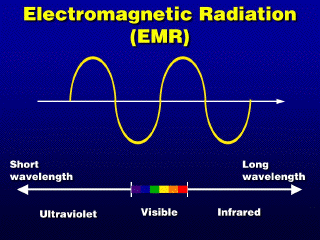 Electromagnetic radiation propagates through space as a packet of energy (photons)
with a characteristic wavelength (the distance between adjacent wave
crests, signified by the lowercase greek leter lambda). The amount
of energy per photon is inversely proportional to the wavelength.
Electromagnetic radiation propagates through space as a packet of energy (photons)
with a characteristic wavelength (the distance between adjacent wave
crests, signified by the lowercase greek leter lambda). The amount
of energy per photon is inversely proportional to the wavelength.
Short wavelength radiation includes
ultraviolet (wavelength less than 0.4 micrometers*), which is dangerous
to living tissue. Visible light falls between 0.4 and 0.7 micrometers,
with blue light at the shorter wavelengths and red light at the longer wavelengths.
Infrared radiation, or IR, is at longer wavelengths. To distinguish
IR from radio/TV waves (wavelengths in centimeters and meters), we may put an
upper limit of about 100 micrometers for IR (this is not an absolute upper limit).
*A micrometer
is one millionth of a meter. Short wavelengths are also expressed in nanometers,
which are billionths of a meter (ex., 0.4 micrometers = 400 nanometers).


 Electromagnetic radiation propagates through space as a packet of energy (photons)
with a characteristic wavelength (the distance between adjacent wave
crests, signified by the lowercase greek leter lambda). The amount
of energy per photon is inversely proportional to the wavelength.
Electromagnetic radiation propagates through space as a packet of energy (photons)
with a characteristic wavelength (the distance between adjacent wave
crests, signified by the lowercase greek leter lambda). The amount
of energy per photon is inversely proportional to the wavelength.